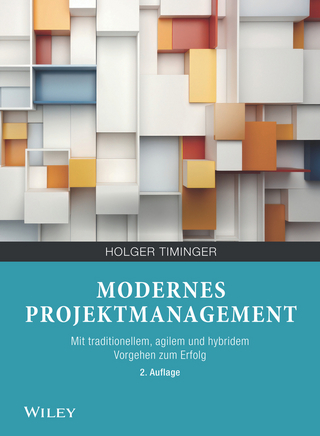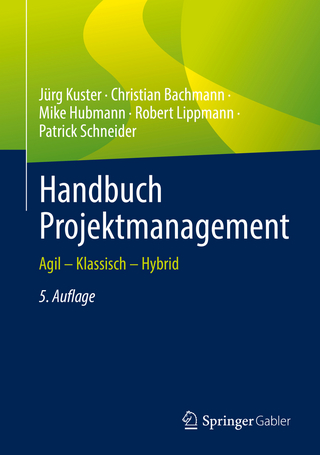
The 12 Pillars of Project Excellence
Productivity Press (Verlag)
978-1-4987-4163-7 (ISBN)
- Titel z.Zt. nicht lieferbar
- Versandkostenfrei innerhalb Deutschlands
- Auch auf Rechnung
- Verfügbarkeit in der Filiale vor Ort prüfen
- Artikel merken
Winner of a 2013 Axiom Business Book Award
The author provides the cutting-edge methods based on decades of personal practical experience, valuable lessons learned, and authoritative insights gained from leading over 300 projects to successful conclusions. Complete with powerful tools for organizational- and self-assessment on the accompanying CD, this book will not only transform your approach to project management, but will also provide you with the tools to develop effective leaders and consistently achieve exceptional business results.
Some Praise for the Book:
… a highly pragmatic guide to project management. … lays out the way of thinking that underpins success… a book that everyone could benefit from.
—Mikel J. Harry, Ph.D., co-creator of Six Sigma
provides the most significant contribution for leaders to mitigate project risks, assure sustainable growth, and guarantee survival… .
—Carlos Alberto Briganti, general manager of Eaton Europe and Japan, 2001-2003; vice president of Eaton South America 2004-2007
… one of the BEST books I have ever read on project leadership.
—John Salazar, CIO Department of Work Force Solutions; former CIO of Department of Taxation & Revenue, State of New Mexico
… a comprehensive guide that will assist any business leader within an organization to consistently achieve excellent business results! A ‘must buy’—get it now!
—Billy Billimoria, director, customer applications, BAE Systems; program director, Lockheed Martin; project engineer, Space Shuttle and Support Equipment Design
Adil Dalal is the CEO of Pinnacle Process Solutions International®. Mr. Dalal is a keynote speaker, author and an internationally recognized expert and thought leader in project leadership and Lean/Advanced Flow Technology. He is well known for pioneering several key advances in project leadership and in Lean, including Lean Project leadership™, iLean® technology, Holistic Model (Lean + iLean)® and lean4kids®. Mr. Dalal’s mission is to focus on enhancing the value of the appreciating assets and optimizing the human potential in addition to developing the necessary technical skills for ensuring the long term success of individuals and corporations. Mr. Dalal holds several degrees: a MS in Engineering Management, a MS in Mechanical Engineering, and a BS in Automotive Engineering. Additionally, he holds numerous certifications, including a Certified Project Manager (PMP), Certified Quality Engineer (CQE) and Certified Lean Bronze Professional (LBC). He is also a Certified Executive Coach. Mr. Dalal has leveraged his expertise in Project Leadership and in Advanced Flow Technology to increase the performance of organizations around the world. His mastery has made Mr. Dalal a sought after strategic business partner and executive coach as he continues to drive excellence by implementing strategies for growth and long-term success. Adil Dalal can be contacted by e-mail at adil@pinnacleprocess.com.
Introduction
Origin of the Term 'Project'
Project Management as a Career Choice
Current State of Project Management
Do Failed Projects = Failed Project Managers?
Criticality of 12 Pillars to Future of Project Leadership
Use of Force Field Analysis11 in the '12 Pillars of Project Excellence'
How can Executives Maximize Profits from Projects
How will Project leaders learn the Art of Mastering the Fundamentals of Project Leadership?
12 Simple Steps to Maximize Benefit from the 12 Pillars
Setting the Right Expectations for This Book
Transformative Power of the 12 Pillars
Please Note: 12 Pillars follows the 'Tao of Simplicity'
Tips for Using the Accompanying CD
Chapter I:
Introduction
Project Manager vs. Project Leader
Five Powers of Project Leaders
Power of Delegation
Power of Dynamic Leadership
Power of Visualization
Power of Lean Thinking
Power of Humility
Pillar I:
Summary
Case Study
Force Field Analysis
Recommendations for Optimal Results from Force Field Analysis
Exercises
References
Chapter II:
Introduction
Factors for project failure
Project Organization Structure
Project Types
Elements of the Project Organization Structure
Responsibility Assignment Matrix
Pillar II:
Summary
Case Study
Force Field Analysis
Force Field Analysis of Organizational Assessment
Force Field Analysis of Self-Assessment
Recommendations for Optimal Results from Force Field Analysis
Exercises
|Organizational Level Skill-Set Enhancement Exercises
Personal Level Skill-Set Enhancement Exercises
References
Chapter III:
Introduction
Delight the Customers
How can a project vision statement be used to delight your customer?
Project vision Statement
Definition
Explanation
Example
Why is a project vision statement important?
How is a project vision statement created?
Steps to Create a Project vision Statement
Create a Project Vision Committee
Review the Charter
Interview Key Stakeholders
Identify the Priority Areas of Focus
Create Initial Project Vision Statement
Brainstorm for the Final Project Vision Statement
Create a Final Powerful Project Vision Statement
The Goal of Creating a Project Vision Statement
Setting higher standards versus 'Gold-Plating'
A Permanent Project vision Statement of Project Leaders
Pillar III:
Summary
Case Study
Force Field Analysis
Force Field Analysis of Organizational Assessment
Force Field Analysis of Self-Assessment
Recommendations for Optimal Results from Force Field Analysis
Exercises
Organizational Level Skill-Set Enhancement Exercises
Personal Level Skill-Set Enhancement Exercises
References
Chapter IV
Introduction
Why projects fail?
Ambiguous Requirements
Importance of Gathering Accurate Requirements
Avoiding the Pitfalls of Ambiguous Requirements
Project Charter: Setting the Longitude and Latitude for a Project
Difference between a Charter and a Vision statement
Does creating a Vision Statement and a Charter Guarantee Project Success?
Developing a Project Charter
Contents in the project charter
Good Charter Vs. Great Charter
Complete Buy-in from all Stakeholders
Signature from Key Stakeholders on the Charter
Difference between use of a Charter by a Project Manager versus a Project Leader
Pillar IV:
Summary
Case Study
Force Field Analysis
Force Field Analysis of Organizational Assessment
Force Field Analysis of Self-Assessment
Recommendations for Optimal Results from Force Field Analysis
Exercises
Organizational Level Skill-Set Enhancement Exercises
Personal Level Skill-Set Enhancement Exercises
References
Chapter V:
Introduction
Why is communication so important?
Why is being an Excellent Communicator Critical?
Why is being an Excellent Communicator Critical to a Project Leader?
Mastering the Art of Excellent Communications
Seven Ingredients to master the art of communication
Diffuse the passion
Pillar V:
Summary
Case Study
Force Field Analysis
Force Field Analysis of Organizational Assessment
Force Field Analysis of Self-Assessment
Recommendations for Optimal Results from Force Field Analysis
Exercises
Organizational Level Skill-Set Enhancement Exercises
Personal Level Skill-Set Enhancement Exercises
References
Chapter VI:
Introduction
Lean technology - Simplifying the project
What is a Lean Technology?
The fundamental principles of Lean
Lean thinking in projects
Identify and Improve Value Added activities
Identify and Reduce Necessary Non-Value Added (NNVA) Activities
Eliminate or Reduce Non-value Added Activities and Eliminate Waste
A Classic Example of Lean
Pillar VI:
Summary
Case Study
Force Field Analysis
Force Field Analysis of Organizational Assessment
Force Field Analysis of Self-Assessment
Recommendations for Optimal Results from Force Field Analysis
Exercises
Organizational Level Skill-Set Enhancement Exercises
Personal Level Skill-Set Enhancement Exercises
References
Chapter VII:
Introduction
Reasons for waste
Meetings- Sources for waste
The Lean Approach to Meetings
Components of a project meeting
Input
Tools and Techniques
Output (Results)
Steps to Eliminate Waste in Meetings
Step 1: Identify and eliminate non-value added meetings
Step 2: Minimize/Eliminate non-value added time
Determination of Productive Meetings
Non-value added time in Complex projects
The Right Approach to Calculate the Project ROI using meeting costs
ROI Calculations without considering Meeting Costs
ROI Calculations considering Meeting Costs
ROI Calculations considering meeting costs but reducing # of Meetings by 50%
Pillar VII:
Summary
Case Study
Force Field Analysis
Force Field Analysis of Organizational Assessment
Force Field Analysis of Self-Assessment
Recommendations for Optimal Results from Force Field Analysis
Exercises
Organizational Level Skill-Set Enhancement Exercises
Personal Level Skill-Set Enhancement Exercises
References
Chapter VIII:
Introduction
Risk Management
Dynamic Risk Leadership
Methodology
Create a risk assessment team
Develop an assessment strategy
Establish clear threat response plan
Unknown risks
Pillar VIII:
Summary
Case Study
Force Field Analysis
Force Field Analysis of Organizational Assessment
Force Field Analysis of Self-Assessment
Recommendations for Optimal Results from Force Field Analysis
Exercises
Organizational Level Skill-Set Enhancement Exercises
Personal Level Skill-Set Enhancement Exercises
References
Chapter IX:
Introduction
What is Information?
What is Data?
Why is timely availability of data critical?
Data Availability through the Ages
Age of Information Overload or Age of Too Much Information (TMI)
A Dynamic Data management Plan
Steps to Designing a Dynamic Data Management Plan
Analysis of Project Data Requirements
Selection of Appropriate Data Type and Sources
Appropriate Data Storage, Security, Retrieval and Distribution
Why is Dynamic Data Management Critical for the Future Success of Project Leaders?
Pillar IX:
Summary
Case Study
Force Field Analysis
Force Field Analysis of Organizational Assessment
Force Field Analysis of Self-Assessment
Recommendations for Optimal Results from Force Field Analysis
Exercises
Organizational Level Skill-Set Enhancement Exercises
Personal Level Skill-Set Enhancement Exercises
References
Chapter X:
Introduction
What is a Failure?
The Difference between a Task Failure and a Project Failure
What do 'Success' and 'Failure' mean to a Project Manager
What do 'Success' and 'Failure' mean to a Project Leader
The Three Modes of Project Failure
System Level failure
Process Level failure
Human Level failure
Approach to Investigate and Address Project Failures
A Reactive analysis using the "Who" approach with primary focus on human level mode of failure
A Proactive analysis using the "Why" approach with a focus on system and process level modes of failure
Pillar X:
Summary
Case Study
Force Field Analysis
Force Field Analysis of Organizational Assessment
Force Field Analysis of Self-Assessment
Recommendations for Optimal Results from Force Field Analysis
Exercises
Organizational Level Skill-Set Enhancement Exercises
Personal Level Skill-Set Enhancement Exercises
References
Chapter XI
Introduction
The impact of stress- A personal experience
What causes stress?
Ambiguous Requirements
Poor or inadequate project planning
Lack of emphasis on understanding Individuals on the Project Team
Impact of stress – an anecdote
Introduction
Experiment
Observation
Results
Lessons Learned
Stress and Human function curve
Project managers- A ‘one size fits all' approach
Project leaders- An 'enlightened' approach
The formula for success
Pillar XI:
Summary
Case Study
Force Field Analysis
Force Field Analysis of Organizational Assessment
Force Field Analysis of Self-Assessment
Recommendations for Optimal Results from Force Field Analysis
Exercises
Organizational Level Skill-Set Enhancement Exercises
Personal Level Skill-Set Enhancement Exercises
References
Chapter XII:
Introduction
Valuing Our True Appreciating Assets
People: The real appreciating assets
The Pinnacle House of Project Excellence
The Unique Philosophy - Dealing with Tough Economic Times
Strengthen the Foundation
Low tide exposes all sharp edges
Create Leaders and Leave a legacy
Reward Consistency of Excellence
Pillar XII:
Summary
Case Study
Force Field Analysis
Force Field Analysis of Organizational Assessment
Force Field Analysis of Self-Assessment
Recommendations for Optimal Results from Force Field Analysis
Exercises
Organizational Level Skill-Set Enhancement Exercises
Personal Level Skill-Set Enhancement Exercises
References
Summary
Summary of 12 Pillars
Conclusion
Five Simple Steps to 'Now, Go Do It'
Know the Purpose-Pursue it!
Winning is Habit - Cultivate it!
There will be Resistance -Face It!
Passion is a Requirement - Show it!
Sky is the Limit - Reach for it!
Conclusion:
Summary
References
Appendix
| Erscheinungsdatum | 17.08.2020 |
|---|---|
| Zusatzinfo | 277 Tables, black and white; 153 Illustrations, black and white |
| Verlagsort | Portland |
| Sprache | englisch |
| Maße | 210 x 280 mm |
| Gewicht | 1610 g |
| Themenwelt | Technik |
| Wirtschaft ► Betriebswirtschaft / Management ► Projektmanagement | |
| ISBN-10 | 1-4987-4163-0 / 1498741630 |
| ISBN-13 | 978-1-4987-4163-7 / 9781498741637 |
| Zustand | Neuware |
| Haben Sie eine Frage zum Produkt? |
aus dem Bereich


